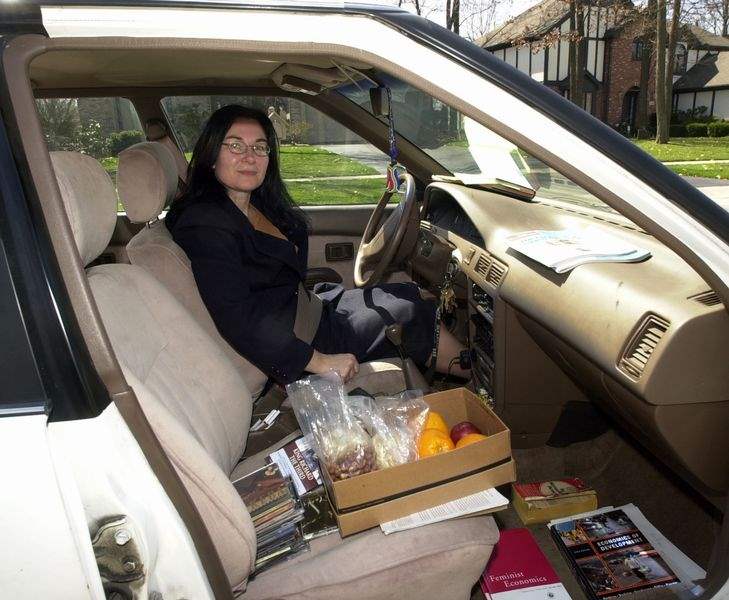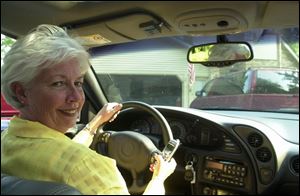
Road warriors
6/30/2002
Diane Monaco has lots of supplies for her 140-mile round-trip commute to and from Manchester College in Indiana.
blade

Diane Monaco has lots of supplies for her 140-mile round-trip commute to and from Manchester College in Indiana.
Up at 3 a.m., Diane Monaco tiptoes out of her Sylvania home by 4 a.m. and begins her 140-mile commute through sleepy villages and farmland. She munches on apples and nuts, plans her day, listens to world music.
At Fort Wayne, she heads 40 miles west for Manchester College. Like many other super-commuters, she's among the first to arrive. By day's end, she'll have spent five hours and 20 minutes in her 11-year-old Chevrolet Prizm, covering 280 miles.
“I find the most trouble-free route where there aren't a lot of cars. And I try to use the time,” said Dr. Monaco, 47. She might be called a commuting professional, having previously shuttled from Sylvania to Detroit and Ypsilanti for jobs and schooling.
Dr. Monaco is an Olympian among the growing cadre of super-commuters. Her fellow roadies include Peg Briggs (she drives from Holland to Livonia, Mich.), Marc Gerstein (he commutes to Toledo from Ann Arbor) and Carol Dalrymple (she leaves her Ottawa home at 5:30 a.m. to get to her job in Toledo).
They are among the more than 10 million Americans making long commutes, said Alan Pisarski, author of Commuting in America. Commutes of more than an hour increased from 7 to 9 percent between 1990 and 2000, according to the U.S. Census. Some of that is due to greater traffic congestion, said Mr. Pisarski, but job choices also play a part.
Nudging the trend, particularly for women, is the cell phone, he noted. “It reduces the sense of being out of touch,” said Mr. Pisarski. Mothers can check in with children or babysitters and make work-related calls.
Reporting the heftiest rise in long commutes were people in West Virginia and Vermont, perhaps, speculated Mr. Pisarski, because rural residents are taking jobs in suburbs at the edges of sprawling cities. Some West Virginians, for example, work in suburban Washington, D.C., he said. He prefers to be drive-free and works out of his home.
Even typical commutes are gobbling up more of our time. In the 21 counties of Northwest Ohio, commutes crept from 19 to 21 minutes between 1990 and 2000, according to the Census. In Lucas County, the average drive to work is 20.5 minutes.
In the three years she has worked at Manchester College, Dr. Monaco has learned to maximize her time on the road. She plans her teaching and her duties as director of the honors program. And she mulls economic issues such as the effects of globalization on labor, or the trafficking of women as commodities, jotting occasional notes on a legal pad.
“It's a very focused time. A lot of ideas in economics you have to really think about - do the connections really exist?” said Dr. Monaco.
She figures she commutes about 27,000 to 30,000 miles a year.
Initially, she drove to the town of North Manchester five days a week, sometimes sleeping on an office couch after teaching a night class. But in the past academic year, her schedule was about as good as any super-commuter and parent of five (ages 8-19) could hope for: Every Monday, Wednesday, and Friday she taught four classes and held three office hours between 7 a.m. and 2 p.m. Most days, that would put her home by about 5 p.m.
“I've worked out something that I feel pretty comfortable with,” said Dr. Monaco, noting that she has four days a week at home and summers and holidays off.
Why does she do it?
Manchester College was the closest job offer she got after earning her doctoral degree. Her husband, Ezzi Salari, is a tenured professor at the University of Toledo. The family talked about moving closer to her job, but with six other family members entrenched in school, work, and activities, it made sense for her to make the adjustments, he said.
She travels with a bag of toiletries, a change of clothes, a shovel in the winter, a cell phone, favorite CDs, and a road-service card.
“I tried books on tape but even when I watch TV [at home], there are so many things I have to do, I get nervous,” she said.
Her husband's role in the home has increased. He gets the four younger children, in middle and high school, off in the morning.
Long drives aren't uncommon for university teachers, especially women, according to the National Faculty Survey of the Higher Education Research Institute at the University of California at Los Angeles. In 2001, 24 percent of female faculty and 18 percent of male faculty reported having long commutes, said UCLA's Jennifer Lindholm. In 1989, comparable figures were 21.4 and 17 percent.
The higher percentage of female commuters may be due to married women being the more likely partner to acquiesce when it comes to career, said Ms. Lindholm, whose 22-mile commute across the City of Angels can take between 35 minutes and three hours.
For 20 years, Marc Gerstein has driven from Ann Arbor to the University of Toledo a couple of times each week. He's a professor of art history. His wife, employed by the University of Michigan, walks three blocks to her job.
After moving from Boston to Toledo in 1980, the couple fell in love with the cultural offerings of Ann Arbor and moved there two years later.
Southbound, Mr. Gerstein, 55, previews what he'll do in class and listens to classical music on Canadian radio. Northbound, he listens to the news and thinks about the day. “It's a little long but it's a kind of decompression,” he said. His vehicle: a 1992 Toyota Camry.

Peg Briggs makes a commute of 70 miles, driveway to driveway, from her home to her job in Livonia, Mich.
Peg Briggs drives 70 miles each way, to and from Livonia, Mich. every day - 130 minutes when the coast is clear. She's at work by 7:15 a.m. and stays until at least 5:30 p.m., usually arriving at her Holland home by 7 p.m.
Ms. Briggs estimates she puts about 38,000 miles on her car each year.
Her most frequently asked question? Why does she do it?
“It was an excellent opportunity, one that has proven to be beneficial for me,” said Ms. Briggs, 55, married and the mother of two adult children living at home. “I like the job and I don't want to move.”
After being laid off from her previous job when her company was sold, she interviewed with American Community Mutual Insurance Co. She has been promoted twice in three years.
Drive time is think time, she said. Four electronic toys help shorten the trip: a radio, compact disc player, cell phone, and a tiny television. She listens to a favorite morning radio program that makes her laugh so much she has missed her exit.
Driving home, she makes work calls, listens to music, and stays alert. And when she's stuck in a traffic snarl, she plugs in the three-inch color television. Her car: a company-owned 2002 Pontiac Bonneville.
Another 140-mile round-trip commuter is Carol Dalrymple, 32, who leaves her Ottawa home at 5:30 a.m. to arrive at work in Toledo at 6:45 a.m. The mother of a preschooler, she works as manager of information management at Mercy Health Partners. She's usually home by 5 p.m.
She estimates that she puts 35,000 miles on her car each year.
She's not fazed by car-time. She lived in California, where her 20-mile commute could take 90 minutes. She listens to favorite radio stations and books on tape.
“The drive is relaxing,” said Ms. Dalrymple, who makes it in a 1994 Chrysler Concord.